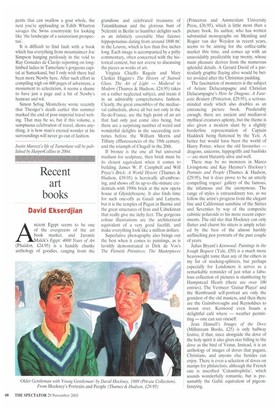Recent art books
David Ekserdjian
Ao4ncient Egypt seems to be one f the evergreens of the art book market, and Jaromir alek's Egypt: 4000 Years of Art (Phaidon, £24.95) is a handily chunky anthology of goodies, ranging from the
grandiose and celebrated treasures of Tutankhamun and the glorious bust of Nefertiti in Berlin to humbler delights such as an infinitely covetable blue faience hippopotamus dating from around 1800 BC in the Louvre, which is less than five inches long. Each image is accompanied by a pithy commentary, often concerned with the historical context, but not averse to discussing the pieces as works of art.
Virginia Chieffo Raguin and Mary Clerkin Higgins's The History of Stained Glass: The Art of Light — Medieval to Modern (Thames & Hudson, £24.95) takes on a rather neglected subject, and treats it in an admirably comprehensive fashion. Clearly, the great ensembles of the mediaeval cathedrals, above all but not only in the Ile-de-France, are the high point of an art that had only just come into being, but there are a surprising number of weird and wonderful delights in the succeeding centuries before the William Morris and Tiffany effloreseences of the 19th century, and the triumph of Chagall in the 20th.
If bronze is the one all but universal medium for sculpture, then brick must be its closest equivalent when it comes to building. James W. P. Campbell and Will Pryce's Brick: A World History (Thames & Hudson, £39.95) is heroically all-embracing, and shows off its up-to-the-minute credentials with 1990s brick at the new opera house at Glyndehourne. It also finds time for such one-offs as Gaudi and Lutyens, but it is the temples of Pagan in Burma and the great structures of Iran and Uzbekistan that really give me itchy feet. The gorgeous colour illustrations are the architectural equivalent of a very good facelift, and make everything look like a million dollars.
Superlative photography also brings out the best when it comes to paintings, as is lavishly demonstrated in Dirk de Vos's The Flemish Primitives: The Masterpieces (Princeton and Amsterdam University Press, £36.95), which is little more than a picture book. Its author, who has written substantial monographs on Memling and Rogier van der Weyden in recent years, seems to be aiming for the coffee-table market this time, and comes up with an unavoidably predictable top twenty, whose main pleasure derives from the numerous splendid details. A Gerard David of a particularly graphic flaying alive would be better avoided after the Christmas pudding.
The fascination of monsters is the subject of Ariane Delacampagne and Christian Delacampagne's Here be Dragons: A Fantastic Bestiary (Princeton, £29.95), a seriousminded study which also doubles as an entrancing picture book. Predictably enough, there are ancient and mediaeval mythical creatures aplenty, but the theme is also given a modern slant by a slightly borderline representation of Captain Haddock being flattened by the Yeti. A better bet would have been the world of Harry Potter, where the old favourites — dragons, unicorns, hippogriffs and basilisks — are most blatantly alive and well.
There may be no monsters in Marco Livingstone and Kay Heymer's Hackney's Portraits and People (Thames & Hudson, £29.95), but it does prove to be an utterly compelling rogues' gallery of the famous, the infamous and the anonymous. The range of styles is extraordinary too, as we follow the artist's progress from the elegant line and Californian sunshine of the Sixties and Seventies by way of the composite cubistic polaroids to his more recent experiments. The old slur that Hockney can only flatter and charm his sitters is amply refuted by the best of the almost harshly unflinching pen portraits of the past couple of years.
Julius Bryant's Kenwooth Paintings in the Iveagh Bequest (Yale, £50) is a much more heavyweight tome than any of the others in my list of stocking-splitters, but perhaps especially for Londoners it serves as a remarkable reminder of just what a fabulous collection of pictures is slumbering by Hampstead Heath (there are over 100 entries). The Vermeer 'Guitar Player' and the Rembrandt self-portrait are only the grandest of the old masters, and then there are the Gainsboroughs and Reynoldses to swoon over. Kenwood even boasts a delightful cafe where — weather permitting — one can sun oneself.
Jean Hansell's Images of the Dove (Millstream Books, £25) is only halfway festive, if that, since alongside the dove of the holy spirit it also gives star billing to the dove as the bird of Venus. Instead, it is an anthology of images of doves that pagans, Christians, and anyone else besides can enjoy. There is even a selection of doves on stamps for philatelists, although the French one is inscribed `Colombophilie', which sounds wonderfully romantic, but is presumably the Gallic equivalent of pigeonfancying.


























































































 Previous page
Previous page